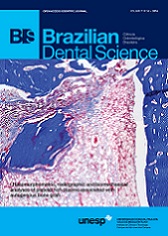Comparative evaluation of blood pressure measuring equipment
DOI:
https://doi.org/10.14295/bds.2014.v17i4.1007Abstract
Objective: This study evaluated the agreement of blood pressure measurements obtained through different auscultatory and oscillometric automated/semi-automated monitors. Material and Methods: The blood pressure of 30 participants was evaluated by a single calibrated examiner. The measurements were carried out through either auscultatory monitor (mercury column or aneroid) or automated/semiautomated oscillometric pulse monitors. For each participant, 5 min rest was established by sitting on dental chair and the measurements were always carried out on the left arm, at the heart level. Three consecutive measurements were performed with the four monitors in each participant with a minimum time interval of five minutes between each measurement. All monitors were properly calibrated and certified by INMETRO. The results were submitted to intraclass correlation coefficient and Friedman’s analysis of variance. Results: The measurements of systolic blood pressure for both auscultatory and oscillometric methods were similar. The measurements of diastolic blood pressure for auscultatory monitors were similar (p > 0.05); as well as for oscillometric monitors (p > 0.05). However, when auscultatory and oscillometric monitors were compared, there were statistically significant differences in diastolic blood pressure (p < 0.05). Conclusion: It was verified a difference in the results between the auscultatory and oscillometric blood pressure monitors. The systolic blood pressure measurements exhibited similar correlations, while
diastolic blood pressure measurements showed different correlations.
Downloads
Downloads
Published
How to Cite
Issue
Section
License
Brazilian Dental Science uses the Creative Commons (CC-BY 4.0) license, thus preserving the integrity of articles in an open access environment. The journal allows the author to retain publishing rights without restrictions.
=================




























